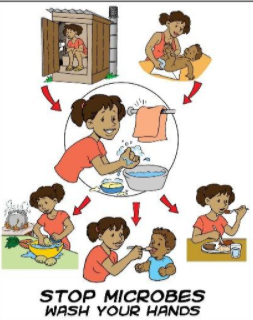
Explain the relationship between sanitation and disease.
Answer
497.7k+ views
Hint: Absence of appropriate sanitation causes diseases. The vast majority of the infections coming about because of sterilization have an immediate connection to destitution. The absence of clean water and helpless disinfection causes numerous maladies and the spread of illnesses.
Complete answer:
Sanitation: Disinfection is cited to general wellbeing conditions identified with clean drinking water and satisfactory treatment and removal of human excreta and sewage. Forestalling human contact with dung is essential for disinfection, as is hand washing with cleanser.
Relationship between sanitation and diseases:
In our nation, a large number of people even today do not have sewerage facilities, even today don't have sewerage offices and along these lines poop in open fields, railroad tracks, and so on. The untreated human excreta along these lines dirty soil and water sources including the underground water. At the point when this tainted water is utilized for drinking, it can cause infections, for example, cholera, typhoid, hepatitis, loose bowels, and so on which may even prompt demise. Hence, the absence of sterilization bringing about the drinking of polluted water can mess wellbeing up. On the off chance that sterilization is there, no malady will happen, however on the off chance that disinfection isn't there different sorts of sickness will happen and spread. So, disinfection ought to be kept to stay away from malady.

Note:Poor sanitation is connected to transmission of diseases for example, cholera, looseness of the bowels, diarrhea, hepatitis A, typhoid and polio and fuels hindering. Helpless sterilization lessens human prosperity, social and monetary improvement because of effects, for example, nervousness, danger of rape, and lost instructive chances.
Complete answer:
Sanitation: Disinfection is cited to general wellbeing conditions identified with clean drinking water and satisfactory treatment and removal of human excreta and sewage. Forestalling human contact with dung is essential for disinfection, as is hand washing with cleanser.
Relationship between sanitation and diseases:
In our nation, a large number of people even today do not have sewerage facilities, even today don't have sewerage offices and along these lines poop in open fields, railroad tracks, and so on. The untreated human excreta along these lines dirty soil and water sources including the underground water. At the point when this tainted water is utilized for drinking, it can cause infections, for example, cholera, typhoid, hepatitis, loose bowels, and so on which may even prompt demise. Hence, the absence of sterilization bringing about the drinking of polluted water can mess wellbeing up. On the off chance that sterilization is there, no malady will happen, however on the off chance that disinfection isn't there different sorts of sickness will happen and spread. So, disinfection ought to be kept to stay away from malady.

Note:Poor sanitation is connected to transmission of diseases for example, cholera, looseness of the bowels, diarrhea, hepatitis A, typhoid and polio and fuels hindering. Helpless sterilization lessens human prosperity, social and monetary improvement because of effects, for example, nervousness, danger of rape, and lost instructive chances.
Latest Vedantu courses for you
Grade 11 Science PCM | CBSE | SCHOOL | English
CBSE (2025-26)
School Full course for CBSE students
₹41,848 per year
Recently Updated Pages
Master Class 9 General Knowledge: Engaging Questions & Answers for Success

Master Class 9 English: Engaging Questions & Answers for Success

Master Class 9 Science: Engaging Questions & Answers for Success

Master Class 9 Social Science: Engaging Questions & Answers for Success

Master Class 9 Maths: Engaging Questions & Answers for Success

Class 9 Question and Answer - Your Ultimate Solutions Guide

Trending doubts
Give 10 examples of unisexual and bisexual flowers

Draw a labelled sketch of the human eye class 12 physics CBSE

Differentiate between homogeneous and heterogeneous class 12 chemistry CBSE

Differentiate between insitu conservation and exsitu class 12 biology CBSE

What are the major means of transport Explain each class 12 social science CBSE

Why is the cell called the structural and functional class 12 biology CBSE




